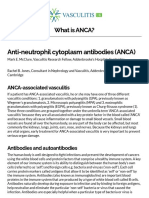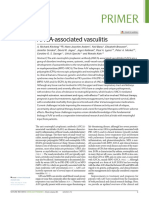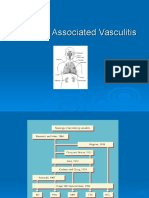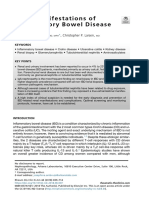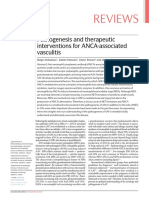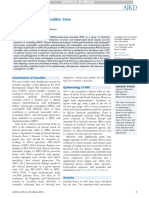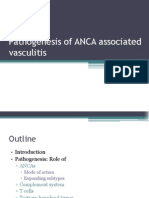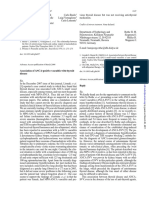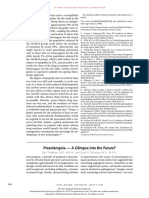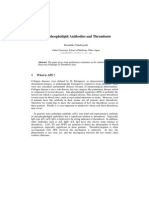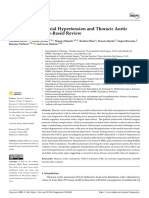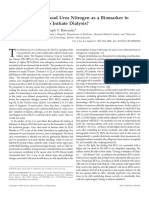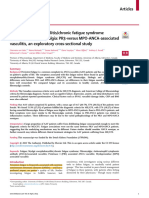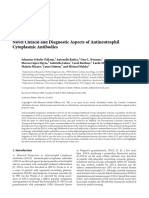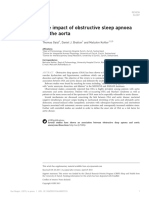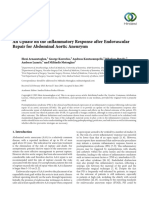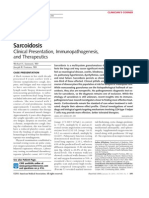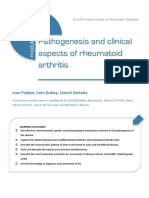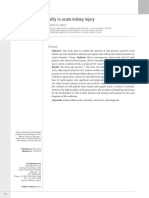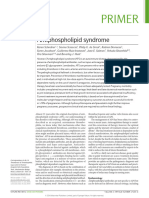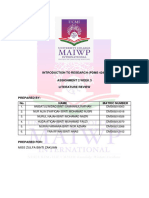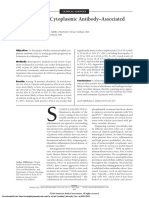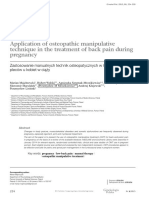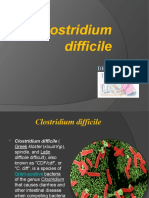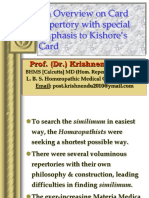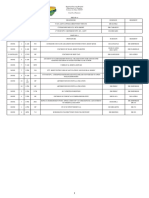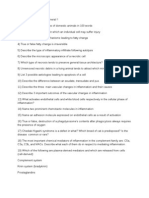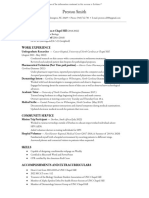Systemic Vasculitis & Alpha-1 Antitrypsin Deficiency
Systemic Vasculitis & Alpha-1 Antitrypsin Deficiency
Uploaded by
Gema Tirado - CondeCopyright:
Available Formats
Systemic Vasculitis & Alpha-1 Antitrypsin Deficiency
Systemic Vasculitis & Alpha-1 Antitrypsin Deficiency
Uploaded by
Gema Tirado - CondeOriginal Title
Copyright
Available Formats
Share this document
Did you find this document useful?
Is this content inappropriate?
Copyright:
Available Formats
Systemic Vasculitis & Alpha-1 Antitrypsin Deficiency
Systemic Vasculitis & Alpha-1 Antitrypsin Deficiency
Uploaded by
Gema Tirado - CondeCopyright:
Available Formats
Vasculitis You what?????
AAT deficiency and natural history Going through the pathogenic link Relevant studies Conclusions
Vasculitis You what????? AAT deficiency and natural history Going through the pathogenic link Relevant studies Conclusions
Non specific term Systemic process Non specific manifestations
Large & heterogeneous group of disorders characterized by
Inflammation of blood vessels
Vasculitis You what????? AAT deficiency and natural history Going through the pathogenic link Relevant studies Conclusions
COPD enphysema
Airflow obstruction asthma Bronchial hiperresponssiveness
bronchiectasis Others: renal, vasculitis, etc Lung disease
Liver disease
Genetic disorder AATD
There is evidence of an association between AATD & systemic vasculitis. AAT deficiency alone is not usually enough to cause sysitemic vasculitis in the absence of other genetic and environmental risk factors.
Vasculitis You what????? AAT deficiency and natural history Going through the pathogenic link Relevant studies Conclusions
Neutrophil elastase is released during times of inflammation. This action is normally helpful and is balanced (neutralized) by the protein a-1 antitrypsin produced in the liver.
One cause of damage to any tissue is that elastase is produced by neutrophil but there is a genetically lack of a-1 antitrypsin.
macrophage Airwways aneutrophils activation
Elastase
LTB4
Neutrophile recruitment
Destruction area
S. Stolk. Eur Respir Mon 2006; 34: 139-150
There are normal regulatory mechanisms for control of secreted neutrophil enzymes and control pathways to limit the enzyme action by anti-proteases. These are highly important for neutralization of the enzymatic activities of the neutrophil proteases.
Anti-protease shield prevents degradation of normal tissues
Then how can the neutrophil perform its normal functions?
Subsequent to this attack on anti-proteases, the neutrophil enzymes are free to damage the bacterial targets, necrotic tissues, or in pathological condition normal tissues.
Vasculitis You what????? AAT deficiency and natural history Going through the pathogenic link Relevant studies Conclusions
Its been described that ANCA activate primed neurophiles and possibly induce accelerate apoptosis of tumor necrosis factor-primed neutrophils.
Actually, the titer of ANCA is correlated with the disease activity, and rises prior to clinical manifestations .
Savage COS et al. Lancet 1987; 1: 1389-93
The main antigenic targets for ANCA are proteinase 3 (PR3) and myeloperoxidase (MPO).
MPO
AAT
PR3
cANCA
pANCA
Rao Nvet al. J Biol Chem 1991; 266: 9540-48
Accordingly it is likely proteases play a role in pathogenesis of systemic vasculitis protease/antiprotease imbalance, which may be either :
genetically determined in AATD pathological acquire inactivation.
Rao Nvet al. J Biol Chem 1991; 266: 9540-48
In some cases the serum is negative for ANCA, and it is apparent that other something than PR3-ANCA plays a role in releasing PR3.
A subpopulation of AATD Pi*ZZ associated with ANCA(+) plus systemic vasculitis has been reported, but it was demonstrated there is no evidence that a Pi*ZZ patient carrying ANCA against PR3 or MPO has a greater risk of developing systemic vasculitis than a Pi*MM patient carrying ANCA
Audrain MAP et al. Nephrol Dial Transplant 2001; 16: 31-44
Although the vasculitis associated with AATD showed a more widespread and worse prognosis than vasculitis, in Pi*MM patients, there was no difference in age at onset or relapse tendency.
Audrain MAP et al. Nephrol Dial Transplant 2001; 16: 31-44
Previous reports have suggested an association between certain ANCA(+) vasculitis and AATD phenotypes .
Esnault Vet al. Kidney Int 1993; 43: 1329-1332
However, other small studies have given conflicting results, so it is unclear whether this is a consistent association and, if so, whether it is of significance as regards disease manifestations.
Elzouki AN et al. J Intern Med 1994; 236: 543-548 O'Donaghue D et al. In: Gross WL, ed. ANCA-Associated Vasculitides: Immunological and Clinical Aspects. Plenum Press, NY1993; 331-335
Vasculitis You what????? AAT deficiency and natural history Going through the pathogenic link Relevant studies Conclusions
ANCA neutrophil activation releasing proteases and ROS, which may result in systemic vasculitis. Since vasculitis didnt result from the production of ANCA in some patients, the evidence suggests
AATD may be a serious genetic factor exacerbating the vasculitis regardless of the relation with ANCA.
You might also like
- What Is ANCA - Vasculitis UKDocument6 pagesWhat Is ANCA - Vasculitis UKNaresh KumarNo ratings yet
- Primer: ANCA-associated VasculitisDocument27 pagesPrimer: ANCA-associated VasculitisMedicinaNo ratings yet
- ANCA Associated VasculitisDocument27 pagesANCA Associated VasculitisAnaNo ratings yet
- ANCA Associated VasculitisDocument62 pagesANCA Associated VasculitispoluashokNo ratings yet
- DrugAINReview 2Document11 pagesDrugAINReview 2Kanaya ChinguNo ratings yet
- Mckenna 1991Document10 pagesMckenna 1991IsmaelNo ratings yet
- Involucro Renal en Enf ReumatoideaDocument16 pagesInvolucro Renal en Enf ReumatoideaRodas LisNo ratings yet
- Pathogenesis and Therapeutic ANCA Associated VasculitisDocument11 pagesPathogenesis and Therapeutic ANCA Associated VasculitisArief KamilNo ratings yet
- Vaculitis Revisión AJKD2019Document14 pagesVaculitis Revisión AJKD2019dennNo ratings yet
- Pathogenesis ANCA Associated Vasculitis - PPTX FINALDocument59 pagesPathogenesis ANCA Associated Vasculitis - PPTX FINALVenkataramanan KrishnamoorthyNo ratings yet
- Anti-Neutrophil Cytoplasmic Antibody (ANCA) Associated VasculitisFrom EverandAnti-Neutrophil Cytoplasmic Antibody (ANCA) Associated VasculitisRenato Alberto SinicoNo ratings yet
- Critical Care Nephrology Core Curriculum 2020 PDFDocument18 pagesCritical Care Nephrology Core Curriculum 2020 PDFMartín FleiNo ratings yet
- TMP 7847Document1 pageTMP 7847FrontiersNo ratings yet
- The Key Role of Uric Acid inDocument10 pagesThe Key Role of Uric Acid intinatobingNo ratings yet
- ProktitisDocument13 pagesProktitisRENTI NOVITANo ratings yet
- Pre EclampsiaDocument3 pagesPre EclampsiaFitra HadiNo ratings yet
- APS & ThrombosisDocument4 pagesAPS & ThrombosisAlpascaFirdausNo ratings yet
- 1 s2.0 S0272638622009222 MainDocument12 pages1 s2.0 S0272638622009222 MainResidenPatKlin Juli2022No ratings yet
- Diagnostics: Rare Causes of Arterial Hypertension and Thoracic Aortic Aneurysms-A Case-Based ReviewDocument16 pagesDiagnostics: Rare Causes of Arterial Hypertension and Thoracic Aortic Aneurysms-A Case-Based ReviewBreeze ChloeNo ratings yet
- GFZ 128Document3 pagesGFZ 128Kev Jose Ruiz RojasNo ratings yet
- 903 FullDocument2 pages903 FullDesi HutapeaNo ratings yet
- A SC Ites: Diagnosis Andmanagement: Wei Hou,, Arun J. SanyalDocument17 pagesA SC Ites: Diagnosis Andmanagement: Wei Hou,, Arun J. SanyalNicole Zavaleta VelásquezNo ratings yet
- 2023 38 2 163 173 EngDocument11 pages2023 38 2 163 173 EngHashem Essa QatawnehNo ratings yet
- J Immunol-2009-Chen-1797-803Document8 pagesJ Immunol-2009-Chen-1797-803Siskawati SuparminNo ratings yet
- CE Update: Wegener's Granulomatosis: A Review of The Clinical Implications, Diagnosis, and TreatmentDocument3 pagesCE Update: Wegener's Granulomatosis: A Review of The Clinical Implications, Diagnosis, and TreatmentAfif FaiziNo ratings yet
- MainDocument10 pagesMainhimalayarthritisNo ratings yet
- JCTH 7 154Document11 pagesJCTH 7 154Andreea AlexandruNo ratings yet
- Acute Kidney Injury and Proteinuria in A Man With HemoptysisDocument3 pagesAcute Kidney Injury and Proteinuria in A Man With HemoptysisChe GuevaraNo ratings yet
- Novel Clinical and Diagnostic Aspects of Antineutrophil Cytoplasmic AntibodiesDocument12 pagesNovel Clinical and Diagnostic Aspects of Antineutrophil Cytoplasmic AntibodiesChristian La RosaNo ratings yet
- The Impact of Obstructive Sleep Apnoea On The Aorta: Thomas Gaisl, Daniel J. Bratton and Malcolm KohlerDocument13 pagesThe Impact of Obstructive Sleep Apnoea On The Aorta: Thomas Gaisl, Daniel J. Bratton and Malcolm KohlerPRABHUDUTTA RAYNo ratings yet
- Polyarteritis NodosaDocument6 pagesPolyarteritis NodosaEkaNo ratings yet
- HshsjneDocument5 pagesHshsjneyunia habsariNo ratings yet
- The Kidneys and ANCA-associated Vasculitis: From Pathogenesis To DiagnosisDocument8 pagesThe Kidneys and ANCA-associated Vasculitis: From Pathogenesis To DiagnosisLiubov PetelytskaNo ratings yet
- Evidence Based Reading FormatDocument2 pagesEvidence Based Reading FormatMarvie TorralbaNo ratings yet
- JurnalDocument7 pagesJurnalIntan Mega PratidianaNo ratings yet
- 566 Letters: A Unifying Hypothesis Is That Activation of Na+/K+Document2 pages566 Letters: A Unifying Hypothesis Is That Activation of Na+/K+saadsffggeettrgbfbfbftggrg ergrtertererefrerrNo ratings yet
- P Primary Open-Angle PatofisDocument2 pagesP Primary Open-Angle Patofisleonblizzara696No ratings yet
- Sarcoidosis Review. JAMADocument9 pagesSarcoidosis Review. JAMARafael ReañoNo ratings yet
- ANCA Glomerulonephritis and VasculitisDocument12 pagesANCA Glomerulonephritis and VasculitisSofía Elizabeth BlancoNo ratings yet
- Fullpapers Fmi24c962d2fafullDocument9 pagesFullpapers Fmi24c962d2fafullfita triastuti /ananda syifa ahmad syamilNo ratings yet
- Aggarwal 2015Document15 pagesAggarwal 2015Abdul RahmanNo ratings yet
- 10.2215@Cjn.13191118 Aki y PancreatitisDocument10 pages10.2215@Cjn.13191118 Aki y Pancreatitishemer hadyn calderon alvitesNo ratings yet
- Pathogenesis and Clinical Aspects of Rheumatoid Arthritis: Ivan Padjen, Cem Gabay, Daniel AletahaDocument83 pagesPathogenesis and Clinical Aspects of Rheumatoid Arthritis: Ivan Padjen, Cem Gabay, Daniel AletahaPankaj VatsaNo ratings yet
- Effectiveness of N-Acetylcysteine For The Prevention of Contrast Induced NephropathyDocument31 pagesEffectiveness of N-Acetylcysteine For The Prevention of Contrast Induced NephropathyeeleeNo ratings yet
- Risk Factors For Mortality in Acute Kidney InjuryDocument6 pagesRisk Factors For Mortality in Acute Kidney Injuryredouane bennaiNo ratings yet
- Involvement of MnSOD Ala16Val Polymorphism in Epilepsy A Relationship With Seizure TypeDocument6 pagesInvolvement of MnSOD Ala16Val Polymorphism in Epilepsy A Relationship With Seizure TypeDetector BotsNo ratings yet
- Patofisiologi OSADocument12 pagesPatofisiologi OSAFany SholehaNo ratings yet
- Evidence Based Reading - FormatDocument2 pagesEvidence Based Reading - FormatMarvie TorralbaNo ratings yet
- 10 1038@nrdp2017103 PDFDocument20 pages10 1038@nrdp2017103 PDFmschlindweinNo ratings yet
- Assignment 2 Week 3 - Apa Exercise - pdms4343 Itr - Group 5Document7 pagesAssignment 2 Week 3 - Apa Exercise - pdms4343 Itr - Group 5dhakimy62No ratings yet
- Diagnostic Pathology of Hematopoietic Disorders of Spleen and LiverFrom EverandDiagnostic Pathology of Hematopoietic Disorders of Spleen and LiverNo ratings yet
- Brain Kidney Interactions in Post Traumatic Brain Death PDFDocument6 pagesBrain Kidney Interactions in Post Traumatic Brain Death PDFspeed_09No ratings yet
- Letters To The Editors: Primary Sjögren's Syndrome As Paraneoplastic Disorder: A Case ReportDocument1 pageLetters To The Editors: Primary Sjögren's Syndrome As Paraneoplastic Disorder: A Case ReportDarian AngNo ratings yet
- Antineutrophil Cytoplasmic Antibody-Associated Active ScleritisDocument5 pagesAntineutrophil Cytoplasmic Antibody-Associated Active ScleritisHackerNo ratings yet
- Antibiotic Prophylaxis For The Prevention of Recurrent Urinary TDocument7 pagesAntibiotic Prophylaxis For The Prevention of Recurrent Urinary Tarilahmad0309No ratings yet
- Natural History of Asymptomatic Severe Aortic StenosisDocument11 pagesNatural History of Asymptomatic Severe Aortic StenosisGaal PinNo ratings yet
- s13023 015 0302 1 PDFDocument14 pagess13023 015 0302 1 PDFNur Alfia KusumaningsihNo ratings yet
- Beyond the Aorta: Exploring the Depths of Abdominal Aortic AneurysmFrom EverandBeyond the Aorta: Exploring the Depths of Abdominal Aortic AneurysmNo ratings yet
- Auto-Inflammatory Syndromes: Pathophysiology, Diagnosis, and ManagementFrom EverandAuto-Inflammatory Syndromes: Pathophysiology, Diagnosis, and ManagementPetros EfthimiouNo ratings yet
- T3, T4, TSH Levels in HypothyroidismDocument6 pagesT3, T4, TSH Levels in HypothyroidismInternational Organization of Scientific Research (IOSR)No ratings yet
- O Inappropriate Seasonal Dress: Violence and AbuseDocument10 pagesO Inappropriate Seasonal Dress: Violence and AbuseJamie LeeNo ratings yet
- Ayurveda at KaivalyadhamaDocument8 pagesAyurveda at KaivalyadhamaAnshumaan SinghNo ratings yet
- Ghana ProgrammeDocument6 pagesGhana ProgrammeAdjei Fosu KennedyNo ratings yet
- Sep SalesDocument77 pagesSep Sales133gagaggaNo ratings yet
- DurolaneDocument14 pagesDurolaneGiieeeNo ratings yet
- DR Reddy - Deep SanghaviDocument10 pagesDR Reddy - Deep SanghaviDeep SanghaviNo ratings yet
- Closed Fracture Neck FemurDocument31 pagesClosed Fracture Neck FemurKiki Said100% (1)
- Application of Osteopathic Manipulative Technique in The Treatment of Back Pain During PregnancyDocument5 pagesApplication of Osteopathic Manipulative Technique in The Treatment of Back Pain During PregnancycrusNo ratings yet
- Clostridium Difficile: Dr.T.V.Rao MDocument67 pagesClostridium Difficile: Dr.T.V.Rao Mtummalapalli venkateswara raoNo ratings yet
- Clinical Nursing Judgement PaperDocument7 pagesClinical Nursing Judgement Paperapi-455663099100% (1)
- Plyometric and Speed Training - Part ADocument32 pagesPlyometric and Speed Training - Part Aivan100% (1)
- Pt. Mulya Husada Jaya: Hospital & General SupplierDocument23 pagesPt. Mulya Husada Jaya: Hospital & General SupplierSahil IlyNo ratings yet
- Card RepertoryDocument23 pagesCard RepertorylucasNo ratings yet
- BivvkhDocument1 pageBivvkhDhila SafirinaNo ratings yet
- July 24 orDocument1 pageJuly 24 orนีล ไบรอันNo ratings yet
- LittleBkEnergyMedicine PDFDocument10 pagesLittleBkEnergyMedicine PDFshafiuthaNo ratings yet
- Delivery Room Dads Do More Harm Than GoodDocument6 pagesDelivery Room Dads Do More Harm Than GoodEr IcNo ratings yet
- Midterm Case Discussions (Urticaria) - 3Document55 pagesMidterm Case Discussions (Urticaria) - 3Geevee Naganag VentulaNo ratings yet
- Oncology and Basic ScienceDocument576 pagesOncology and Basic ScienceNegreanu Anca100% (2)
- Pharmacokinetics and Pharmacodynamics 40Document40 pagesPharmacokinetics and Pharmacodynamics 40Shoaib Biradar100% (1)
- Daftar Pustaka: Anesthesiology". Lange Medical Books/Mcgraw-Hill. New York 2013Document1 pageDaftar Pustaka: Anesthesiology". Lange Medical Books/Mcgraw-Hill. New York 2013Libna ShabrinaNo ratings yet
- 2 - Swimmers DevelopmentDocument6 pages2 - Swimmers DevelopmentDenis OsmenajNo ratings yet
- Depression Theory PDFDocument2 pagesDepression Theory PDFdonkeyendutNo ratings yet
- General Pathology QuizDocument2 pagesGeneral Pathology QuizMatt DickoNo ratings yet
- Preston Smith: EducationDocument1 pagePreston Smith: Educationapi-437394219No ratings yet
- Abruption PacentaDocument6 pagesAbruption PacentaKondapavuluru JyothiNo ratings yet
- Radiology of GITDocument12 pagesRadiology of GITAustine OsaweNo ratings yet
- Semiologic Features and Their Lateralizating andDocument4 pagesSemiologic Features and Their Lateralizating andRobby ZayendraNo ratings yet
- Split BrainDocument20 pagesSplit BrainAnegondi Vamsi Krishna RajuNo ratings yet
